
Scientists Unveil the "Second Heart": Aorta’s Critical Role in Blood Circulation Revealed!
2025-04-06
Author: Wei
Recent scientific breakthroughs have shown that the aorta—the primary blood vessel delivering oxygen-rich blood from the heart throughout the body—has a function that may be far more dynamic than previously understood. Traditionally recognized for its elastic ability to absorb pressure, new research indicates that the aorta actively helps propel blood, essentially acting as a "second heart."
Unlocking the Secrets of Aortic Function
Published in the prestigious Journal of The Royal Society Interface, the study outlines an extraordinary mechanism known as "wave-pumping." This process enables the aorta to stretch and recoil in synchrony with the heart’s rhythm, offering critical support for blood flow, particularly for individuals battling heart failure.
Utilizing cutting-edge magnetic resonance imaging (MRI), researchers studied the aorta’s movement in 159 participants, revealing striking discrepancies in the aortic displacement profiles between healthy individuals and those with heart failure. The results indicated that while healthy participants demonstrated greater aortic stretching, those with heart failure exhibited diminished elasticity, hindering optimal blood circulation.
The Mechanism Behind Aortic Wave-Pumping
The wave-pumping phenomenon occurs during the heart's contraction (systole) when the aorta expands, followed by recoil during the relaxation phase (diastole). This recoil releases stored energy, facilitating continuous blood flow and working alongside the heart's pumping action, thereby enhancing blood distribution without necessitating extra heartbeats.
Such findings shed light on a previously underappreciated facet of cardiovascular physiology. The aorta’s ability to augment circulation could significantly lessen the burden on the heart, especially for those with diminished cardiac output, ensuring that vital organs continue to receive sufficient oxygen and nutrients.
Transformative Implications for Heart Failure Treatment
The potential implications of this discovery for treating heart failure are immense. Researchers are now focusing on therapeutic strategies aimed at improving aortic elasticity to bolster circulation in heart failure patients. While some antihypertensive medications have shown effectiveness in reducing arterial stiffness, further exploration is necessary to assess their influence on the aorta’s newly identified wave-pumping function.
Moreover, these insights may clarify why some individuals with compromised heart function can still maintain adequate blood circulation. The aorta's role as a supplemental pump may be crucial, compensating for the heart's reduced pumping capability.
In conclusion, the emerging understanding of the aorta's wave-pumping effect highlights the complexity of our circulatory system. As researchers continue to unveil the mysteries surrounding the "second heart," we may soon be able to refine our approaches to heart failure treatment, potentially transforming the lives of millions affected by cardiovascular diseases.

 Brasil (PT)
Brasil (PT)
 Canada (EN)
Canada (EN)
 Chile (ES)
Chile (ES)
 Česko (CS)
Česko (CS)
 대한민국 (KO)
대한민국 (KO)
 España (ES)
España (ES)
 France (FR)
France (FR)
 Hong Kong (EN)
Hong Kong (EN)
 Italia (IT)
Italia (IT)
 日本 (JA)
日本 (JA)
 Magyarország (HU)
Magyarország (HU)
 Norge (NO)
Norge (NO)
 Polska (PL)
Polska (PL)
 Schweiz (DE)
Schweiz (DE)
 Singapore (EN)
Singapore (EN)
 Sverige (SV)
Sverige (SV)
 Suomi (FI)
Suomi (FI)
 Türkiye (TR)
Türkiye (TR)
 الإمارات العربية المتحدة (AR)
الإمارات العربية المتحدة (AR)